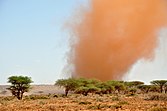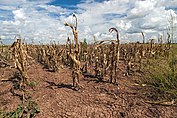Forest management
It has been suggested that Proforestation, Afforestation and Sustainable forest management be merged into this article. (Discuss) Proposed since April 2024. |
Forest management is a branch of forestry concerned with overall administrative, legal, economic, and social aspects, as well as scientific and technical aspects, such as silviculture, protection, and forest regulation. This includes management for timber, aesthetics, recreation, urban values, water, wildlife, inland and nearshore fisheries, wood products, plant genetic resources, and other forest resource values.[1] Management objectives can be for conservation, utilisation, or a mixture of the two. Techniques include timber extraction, planting and replanting of different species, building and maintenance of roads and pathways through forests, and preventing fire.
Many tools like remote sensing, GIS and photogrammetry[2][3] modelling have been developed to improve forest inventory and management planning.[4] Since 1953, the volume of standing trees in the United States has increased by 90% due to sustainable forest management.[5]
Definition[edit]
The forest is a natural system that can supply different products and services. Forests supply water, mitigate climate change, provide habitats for wildlife including many pollinators which are essential for sustainable food production, provide timber and fuelwood, serve as a source of non-wood forest products including food and medicine, and contribute to rural livelihoods.[6]
The working of this system is influenced by the natural environment: climate, topography, soil, etc., and also by human activity. The actions of humans in forests constitute forest management.[7] In developed societies, this management tends to be elaborated and planned in order to achieve the objectives that are considered desirable.[citation needed]
Some forests have been and are managed to obtain traditional forest products such as firewood, fiber for paper, and timber, with little thinking for other products and services. Nevertheless, as a result of the progression of environmental awareness, management of forests for multiple use is becoming more common.[8]
Wildlife considerations[edit]
The abundance and diversity of birds, mammals, amphibians and other wildlife are affected by strategies and types of forest management.[9] Forests are important because they provide these species with food, space and water.[10] Forest management is also important as it helps in conservation and utilization of the forest resources.[citation needed]
Approximately 50 million hectares (or 24%) of European forest land is protected for biodiversity and landscape protection. Forests allocated for soil, water, and other ecosystem services encompass around 72 million hectares (32% of European forest area).[11][12][13] Over 90% of the world's forests regenerate organically, and more than half are covered by forest management plans or equivalents.[14][15]
Management intensity[edit]

Forest management varies in intensity from a leave alone, natural situation to a highly intensive regime with silvicultural interventions. Forest Management is generally increased in intensity to achieve either economic criteria (increased timber yields, non-timber forest products, ecosystem services) or ecological criteria (species recovery, fostering of rare species, carbon sequestration).[17]
Most of the forests in Europe have management plans; on the other hand, management plans exist for less than 25 percent of forests in Africa and less than 20 percent in South America. The area of forest under management plans is increasing in all regions – globally, it has increased by 233 million ha since 2000, reaching 2.05 billion ha in 2020.[18]
Public input and awareness[edit]
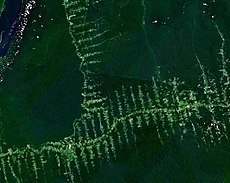
There has been increased public awareness of natural resource policy, including forest management.[citation needed] Public concern regarding forest management may have shifted from the extraction of timber for economic development, to maintaining the flow of the range of ecosystem services provided by forests, including provision of habitat for wildlife, protecting biodiversity, watershed management, and opportunities for recreation. Increased environmental awareness may contribute to an increased public mistrust of forest management professionals.[19] But it can also lead to greater understanding about what professionals do for forests for nature conservation and ecological services. The importance of taking care of the forests for ecological as well as economical sustainable reasons has been shown in the TV show Ax Men.
Community forestry[edit]

Community forestry is a branch of forestry that deals with the communal management of forests for generating income from timber and non-timber forest products as forms of goods while in other hand regulating ecosystem, downstream settlements benefits from watershed conservation, carbon sequestration and aesthetic values as in forms of services. It has been considered one of the most promising options of combining forest conservation with rural development and community empowerment and poverty reduction objectives. Community forestry is defined by the Food and Agricultural Organization of the United Nations as "any situation that intimately involves local people in forestry activity".[20] Community forestry exists when the local community in an area plays a significant role in land use decision-making and when the community is satisfied with its involvement and benefits from the management of the surrounding forest and its resources.[21]
Community forestry is first implemented through the establishment of a legal and institutional framework including the revision of legal norms and regulations for forest management, the development of National Forest Plans and the strengthening of decentralization processes to sub-national levels of government. The second principal line of action is the implementation of pilot projects to demonstrate the feasibility of the community forestry framework [citation needed]. However, a study by the Overseas Development Institute shows that the technical, managerial and financial requirements stipulated by the framework are often incompatible with local realities and interests. A successful legal and institutional framework will incorporate the strengthening of existing institutions and enable the dissemination of locally appropriate practices as well as the local capacity for regulation and control.[22]
In a 2016 review of community-based forestry, FAO estimated that almost one-third of the world's forest area is under some form of community-based management.[23]Sustainable forest management[edit]

Sustainable forest management (SFM) is the management of forests according to the principles of sustainable development. Sustainable forest management must keep a balance between the three main pillars: ecological, economic and socio-cultural. The goal of sustainable forestry is to allow for a balance to be found between making use of trees while maintaining natural patterns of disturbance and regeneration.[24] The forestry industry mitigates climate change by boosting carbon storage in growing trees and soils and improving the sustainable supply of renewable raw materials via sustainable forest management.[25][26]
Successfully achieving sustainable forest management will provide integrated benefits to all, ranging from safeguarding local livelihoods to protecting biodiversity and ecosystems provided by forests, reducing rural poverty and mitigating some of the effects of climate change.[27] Forest conservation is essential to stop climate change.[28][29]
Sustainable forest management also helps with climate change adaptation by increasing forest ecosystems' resistance to future climatic hazards and lowering the danger of additional land degradation by repairing and stabilizing soils and boosting their water-retention capacity.[30][31] It contributes to the provision of a wide range of vital ecosystem services and biodiversity conservation, such as wildlife habitats, recreational amenity values, and a variety of non-timber forest products.[25][32] Conservation of biodiversity is the major management aim in around 13% of the world's forests, while preservation of soil and water resources is the primary management goal in more than 30%.[25][33]
Feeding humanity and conserving and sustainably using ecosystems are complementary and closely interdependent goals. Forests supply water, mitigate climate change and provide habitats for many pollinators, which are essential for sustainable food production. It is estimated that 75 percent of the world's leading food crops, representing 35 percent of global food production, benefit from animal pollination for fruit, vegetable or seed production.[34]
The "Forest Principles" adopted at the Earth Summit (United Nations Conference on Environment and Development) in Rio de Janeiro in 1992 captured the general international understanding of sustainable forest management at that time. A number of sets of criteria and indicators have since been developed to evaluate the achievement of SFM at the global, regional, country and management unit level. These were all attempts to codify and provide for assessment of the degree to which the broader objectives of sustainable forest management are being achieved in practice. In 2007, the United Nations General Assembly adopted the Non-Legally Binding Instrument on All Types of Forests. The instrument was the first of its kind that reflected the strong international commitment to promote implementation of sustainable forest management through a new approach bringing all stakeholders together.[35]
The Sustainable Development Goal 15 is also a global initiative aimed at promoting the implementation of sustainable forest management.[36]Problems[edit]
Drought[edit]
Wildfires[edit]

Forest degradation[edit]

Deforestation[edit]

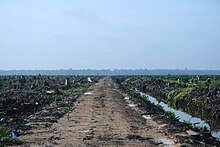

Deforestation or forest clearance is the removal and destruction of a forest or stand of trees from land that is then converted to non-forest use.[50] Deforestation can involve conversion of forest land to farms, ranches, or urban use. About 31% of Earth's land surface is covered by forests at present.[51] This is one-third less than the forest cover before the expansion of agriculture, with half of that loss occurring in the last century.[52] Between 15 million to 18 million hectares of forest, an area the size of Bangladesh, are destroyed every year. On average 2,400 trees are cut down each minute.[53] Estimates vary widely as to the extent of deforestation in the tropics.[54][55] In 2019, nearly a third of the overall tree cover loss, or 3.8 million hectares, occurred within humid tropical primary forests. These are areas of mature rainforest that are especially important for biodiversity and carbon storage.[56][57]
The direct cause of most deforestation is agriculture by far.[58] More than 80% of deforestation was attributed to agriculture in 2018.[59] Forests are being converted to plantations for coffee, palm oil, rubber and various other popular products.[60] Livestock grazing also drives deforestation. Further drivers are the wood industry (logging), urbanization and mining. The effects of climate change are another cause via the increased risk of wildfires (see deforestation and climate change).
Deforestation results in habitat destruction which in turn leads to biodiversity loss. Deforestation also leads to extinction of animals and plants, changes to the local climate, and displacement of indigenous people who live in forests. Deforested regions often also suffer from other environmental problems such as desertification and soil erosion.
Another problem is that deforestation reduces the uptake of carbon dioxide (carbon sequestration) from the atmosphere. This reduces the potential of forests to assist with climate change mitigation. The role of forests in capturing and storing carbon and mitigating climate change is also important for the agricultural sector.[61] The reason for this linkage is because the effects of climate change on agriculture pose new risks to global food systems.[61]
Since 1990, it is estimated that some 420 million hectares of forest have been lost through conversion to other land uses, although the rate of deforestation has decreased over the past three decades. Between 2015 and 2020, the rate of deforestation was estimated at 10 million hectares per year, down from 16 million hectares per year in the 1990s. The area of primary forest worldwide has decreased by over 80 million hectares since 1990. More than 100 million hectares of forests are adversely affected by forest fires, pests, diseases, invasive species, drought and adverse weather events.[62]Deforestation and climate change[edit]

Deforestation is a primary contributor to climate change,[63][64] and climate change affects the health of forests.[65] Land use change, especially in the form of deforestation, is the second largest source of carbon dioxide emissions from human activities, after the burning of fossil fuels.[66][67] Greenhouse gases are emitted from deforestation during the burning of forest biomass and decomposition of remaining plant material and soil carbon. Global models and national greenhouse gas inventories give similar results for deforestation emissions.[67] As of 2019[update], deforestation is responsible for about 11% of global greenhouse gas emissions.[68] Carbon emissions from tropical deforestation are accelerating.[69][70]
When forests grow they are a carbon sink and therefore have potential to mitigate the effects of climate change.Some of the effects of climate change, such as more wildfires,[71] invasive species, and more extreme weather events can lead to more forest loss.[72][73] The relationship between deforestation and climate change is one of a positive (amplifying) climate feedback.[74] The more trees that are removed equals larger effects of climate change which, in turn, results in the loss of more trees.[75]
Forests cover 31% of the land area on Earth. Every year, 75,700 square kilometers (18.7 million acres) of the forest is lost.[76] There was a 12% increase in the loss of primary tropical forests from 2019 to 2020.[77]
Deforestation has many causes and drivers. Examples include agricultural clearcutting, livestock grazing, logging for timber, and wildfires.Unsustainable practices[edit]
Clear-cutting[edit]
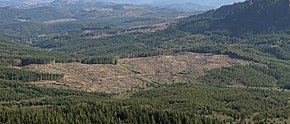
Clearcutting, clearfelling or clearcut logging is a forestry/logging practice in which most or all trees in an area are uniformly cut down. Along with shelterwood and seed tree harvests, it is used by foresters to create certain types of forest ecosystems and to promote select species[78] that require an abundance of sunlight or grow in large, even-age stands.[79] Logging companies and forest-worker unions in some countries support the practice for scientific, safety and economic reasons, while detractors consider it a form of deforestation that destroys natural habitats[80] and contributes to climate change.[81] Environmentalists, traditional owners, local residents and others have regularly campaigned against clearcutting, including through the use of blockades and nonviolent direct action.[82]
Clearcutting is the most common and economically profitable method of logging. However, it also may create detrimental side effects, such as the loss of topsoil, the costs of which are intensely debated by economic, environmental and other interests. In addition to the purpose of harvesting wood, clearcutting is used to create land for farming.[83] Ultimately, the effects of clearcutting on the land will depend on how well or poorly the forest is managed,[84] and whether it is converted to non-forest land uses after clearcuts.[85]
While deforestation of both temperate and tropical forests through clearcutting has received considerable media attention in recent years, the other large forests of the world, such as the taiga, also known as boreal forests, are also under threat of rapid development. In Russia, North America and Scandinavia, creating protected areas and granting long-term leases to tend and regenerate trees—thus maximizing future harvests—are among the means used to limit the harmful effects of clearcutting.[86] Long-term studies of clearcut forests, such as studies of the Pasoh Rainforest in Malaysia, are also important in providing insights into the conservation of forest resources worldwide.[87]Even-aged timber management[edit]
Illegal logging[edit]
Illegal logging is the harvest, transportation, purchase, or sale of timber in violation of laws. The harvesting procedure itself may be illegal, including using corrupt means to gain access to forests; extraction without permission, or from a protected area; the cutting down of protected species; or the extraction of timber in excess of agreed limits. Illegal logging is a driving force for a number of environmental issues such as deforestation, soil erosion and biodiversity loss which can drive larger-scale environmental crises such as climate change and other forms of environmental degradation.
Illegality may also occur during transport, such as illegal processing and export (through fraudulent declaration to customs); the avoidance of taxes and other charges, and fraudulent certification.[90] These acts are often referred to as "wood laundering".[91]
Illegal logging is driven by a number of economic forces, such as demand for raw materials, land grabbing and demand for pasture for cattle. Regulation and prevention can happen at both the supply size, with better enforcement of environmental protections, and at the demand side, such as an increasing regulation of trade as part of the international lumber Industry.Land development[edit]
Mitigation of deforestation and climate change[edit]
Certified wood[edit]
Forest certification is a globally recognized system for encouraging sustainable forest management and assuring that forest-based goods are derived from sustainably managed forests.[92][93][94] This is a voluntary procedure in which an impartial third-party organization evaluates the quality of forest management and output against a set of criteria established by a governmental or commercial certification agency.[95][96]
Forest protection[edit]

Forest protection is a branch of forestry which is concerned with the preservation or improvement of a forest and prevention and control of damage to forest by natural or man made causes like forest fires, plant pests, and adverse climatic conditions (global warming).
Forest protection also has a legal status and rather than protection from only people damaging the forests is seen to be broader and include forest pathology too. Due to the different emphases there exist widely different methods forest protection.
In German-speaking countries, forest protection would focus on the biotic and abiotic factors that are non-crime related. A protected forest is not the same as a protection forest. These terms can lead to some confusion in English, although they are clearer in other languages. As a result, reading English literature can be problematic for non-experts due to localization and conflation of meanings.
The types of man-induced abuse that forest protection seeks to prevent include:
- Aggressive or unsustainable intensive farming and logging
- Pollution of the forest soil
- Expanding city development caused by population explosion and the resulting urban sprawl
Proforestation[edit]

Proforestation is the practice of protecting existing natural forests to foster continuous growth, carbon accumulation, and structural complexity.[99][100] It is recognized as an important forest based strategy for addressing the global crises in climate and biodiversity.[100][101] Forest restoration can be a strategy for climate change mitigation.[102]: 37 Proforestation complements other forest-based solutions like afforestation, reforestation and improved forest management.
Allowing proforestation in some secondary forests will increase their accumulated carbon and biodiversity over time. Strategies for proforestation include rewilding,[103] such as reintroducing apex predators and keystone species as, for example, predators keep the population of herbivores in check (which reduce the biomass of vegetation). Another strategy is establishing wildlife corridors connecting isolated protected areas.[104][105]Tree planting[edit]


Tree planting is the process of transplanting tree seedlings, generally for forestry, land reclamation, or landscaping purposes. It differs from the transplantation of larger trees in arboriculture and from the lower-cost but slower and less reliable distribution of tree seeds. Trees contribute to their environment over long periods of time by providing oxygen, improving air quality, climate amelioration, conserving water, preserving soil, and supporting wildlife. During the process of photosynthesis, trees take in carbon dioxide and produce the oxygen we breathe.
Because trees remove carbon dioxide from the air as they grow, tree planting can be used to help limit climate change. Desert greening projects are also motivated by improved biodiversity and reclamation of natural water systems, as well as improved economic and social welfare due to an increased number of jobs in farming and forestry.Reforestation[edit]


Reforestation is the practice of restoring previously existing forests and woodlands that have been destroyed or damaged. The prior forest destruction might have happened through deforestation, clearcutting or wildfires. Two important purposes of reforestation programs are for harvesting of wood or for climate change mitigation purposes. Reforestation can also help with ecosystem restoration. One method for reforestation is to establish tree plantations, also called plantation forests. They cover about 131 million ha worldwide, which is 3 percent of the global forest area and 45 percent of the total area of planted forests.[106]
Globally, planted forests increased from 4.1% to 7.0% of the total forest area between 1990 and 2015.[107] Plantation forests made up 280 million ha (hectare) in 2015, an increase of about 40 million ha in the last ten years.[108] Globally, planted forests consist of about 18% exotic or introduced species while the rest are species native to the country where they are planted.
There are limitations and challenges with reforestation projects, especially if they are in the form of tree plantations. Firstly, there can be competition with other land uses and displacement risk. Secondly, tree plantations are often monocultures which comes with a set of disadvantages, for example biodiversity loss. Lastly, there is also the problem that stored carbon is released at some point.
The effects of reforestation and afforestation will be farther in the future than those of proforestation (the conservation of intact forests).[109] Instead of planting entirely new areas, it might be better to reconnect forested areas and restoring the edges of forest. This protects their mature core and makes them more resilient and longer-lasting.[110] It takes much longer − several decades − for the carbon sequestration benefits of reforestation to become similar to the those from mature trees in tropical forests. Therefore, reducing deforestation is usually more beneficial for climate change mitigation than reforestation.[111]
Many countries carry out reforestation programs. For example in China, the Three Northern Protected Forest Development Program – informally known as the "Great Green Wall" – was launched in 1978 and scheduled to last until 2050. It aims to eventually plant nearly 90 million acres of new forest in a 2,800-mile stretch of northern China.[112]Forest restoration[edit]

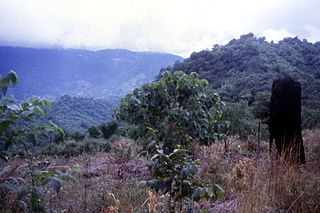
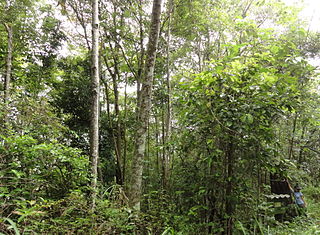
Forest restoration is defined as “actions to re-instate ecological processes, which accelerate recovery of forest structure, ecological functioning and biodiversity levels towards those typical of climax forest”[113] i.e. the end-stage of natural forest succession. Climax forests are relatively stable ecosystems that have developed the maximum biomass, structural complexity and species diversity that are possible within the limits imposed by climate and soil and without continued disturbance from humans (more explanation here). Climax forest is therefore the target ecosystem, which defines the ultimate aim of forest restoration. Since climate is a major factor that determines climax forest composition, global climate change may result in changing restoration aims.[114] Additionally, the potential impacts of climate change on restoration goals must be taken into account, as changes in temperature and precipitation patterns may alter the composition and distribution of climax forests.[115]
Forest restoration is a specialized form of reforestation, but it differs from conventional tree plantations in that its primary goals are biodiversity recovery and environmental protection.[116][117]
Forest and landscape restoration (FLR) is defined as a process that aims to regain ecological functionality and enhance human well-being in deforested or degraded landscapes.[118] FLR has been developed as a response to the growing degradation and loss of forest and land, which resulted in declined biodiversity and ecosystem services.[118] Effective FLR will support the achievement of the Sustainable Development Goals.[118] The United Nations Decade on Ecosystem Restoration (2021–2030) provides the opportunity to restore hundreds of millions of hectares of degraded forests and other ecosystems.[118] Successful ecosystem restoration requires a fundamental understanding of the ecological characteristics of the component species, together with knowledge of how they assemble, interact and function as communities[119]Afforestation[edit]
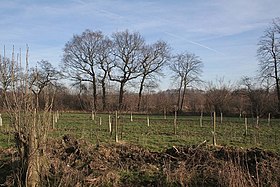
Afforestation is the establishment of a forest or stand of trees (forestation) in an area where there was no recent tree cover.[120] In comparison, reforestation means re-establishing forest that have either been cut down or lost due to natural causes, such as fire, storm, etc.[121] There are three types of afforestation: Natural regeneration, agroforestry and tree plantations.[122] Afforestation has many benefits. In the context of climate change, afforestation can be helpful for climate change mitigation through the route of carbon sequestration. Afforestation can also improve the local climate through increased rainfall and by being a barrier against high winds. The additional trees can also prevent or reduce topsoil erosion (from water and wind), floods and landslides. Finally, additional trees can be a habitat for wildlife, and provide employment and wood products.[122]
Several countries have afforestation programs to increase carbon dioxide removal from forests and to reduce desertification. However, afforestation on grasslands and savanna areas can be problematic. Carbon sequestration estimates in those areas often do not include the full amount of carbon reductions in soils and slowing tree growth over time. Also afforestation can negatively affect biodiversity through increasing fragmentation and edge effects for the habitat remaining outside the planted area.Tropical rainforest conservation[edit]



Building blocks for tropical rainforest conservation include ecotourism and rehabilitation. Reforestation and restoration are common practices in certain areas to try to increase tropical rainforest density. By communicating with the local people living in, and around, the rainforest, conservationists can learn more about what might allow them to best focus their efforts.[123]
Rainforests are globally important to sustainability and preservation of biodiversity. Although they may vary in location and inhabited species of plants and animals, they remain important worldwide for their abundance of natural resources and for the ecosystem services. It is important to take into consideration the differing species and the biodiversity that exists across different rainforest types in order to accurately implement methods of conservation.[124]Forest conservation in the United States[edit]

Forest conservation is the practice of planning and maintaining forested areas for the benefit and sustainability of future generations. Forest conservation involves the upkeep of the natural resources within a forest that are beneficial for both humans and the ecosystem. Forests provide wildlife with a suitable habitat for living which allows the ecosystem to be biodiverse and benefit other natural processes. Forests also filter groundwater and prevent runoff keeping water safe for human consumption.[125] There are many types of forests to consider and various techniques to preserve them. Of the types of forests in the United States, they each face specific threats. But, there are various techniques to implement that will protect and preserve them.
Different types of forests have adapted throughout history, allowing them to thrive in specific habitats. Forests in the United States can be categorized into three main forest biomes, they are boreal, temperate, or sub-tropical based on the location and climate of the forest. Each of these biomes faces various threats of deforestation, urban development,[126] soil compaction, species extinction, unmanaged recreational use, invasive species, or any combination of these threats. But there are many techniques that can be implemented for forest conservation efforts.[127] This includes methods such as afforestation, reforestation, selective logging,[128] controlled burns, wildland fire use, laws and policies,[129] advocacy groups, and wildlife management areas. Additionally, multiple United States government programs support forest conservation efforts.See also[edit]
- Conservation biology
- Coppicing
- Environmental protection
- Forest farming
- Forest inventory
- Forest plans
- Growth and yield modelling
- Habitat conservation
- Outline of forestry
References[edit]
- ^ "Glossary of Forestry Terms in British Columbia" (PDF). Ministry of Forests and Range (Canada). March 2008. Retrieved 2009-04-06.
- ^ I. Balenovich, A. Seletkovich, et al. Comparison of Classical Terrestrial and Photogrammetric Method in Creating Management Division. FORMEC. Croatia 2012. pp. 1-13.
- ^ I. Balenović, D. Vuletić, et al. Digital Photogrammetry – State of the Art and Potential for Application in Forest Management in Croatia. SEEFOR. South-East European Forestry. #2, 2011. pp. 81–93.
- ^ Mozgeris, G. (2008) “The continuous field view of representing forest geographically: from cartographic representation towards improved management planning”. S.A.P.I.EN.S. 1 (2)
- ^ "The Value of Hardwood Floors". Archived from the original on 2021-10-22. Retrieved 2017-01-21.
- ^ The State of the World's Forests 2020. Forests, biodiversity and people – In brief. Rome: FAO & UNEP. 2020. doi:10.4060/ca8985en. ISBN 978-92-5-132707-4. S2CID 241416114.
- ^ "Natural Forest Management". www.fao.org. Retrieved 2022-10-24.
- ^ Young, Raymond (1982). Introduction to Forest Science. John Wiley & sons. p. 207. ISBN 978-0471064381.
- ^ * Philip Joseph Burton. 2003. Towards sustainable management of the boreal forest 1039 pages
- ^ "Home | Ohio Woodland Stewards Program". woodlandstewards.osu.edu. Retrieved 2022-10-24.
- ^ Bank, European Investment (2022-12-08). Forests at the heart of sustainable development: Investing in forests to meet biodiversity and climate goals. European Investment Bank. ISBN 978-92-861-5403-4.
- ^ "Forests - Environment - European Commission". ec.europa.eu. Retrieved 2023-01-30.
- ^ "Protected Forests in Europe" (PDF).
- ^ Bank, European Investment (2022-12-08). Forests at the heart of sustainable development: Investing in forests to meet biodiversity and climate goals. European Investment Bank. ISBN 978-92-861-5403-4.
- ^ Martin. "Forests, desertification and biodiversity". United Nations Sustainable Development. Retrieved 2023-01-30.
- ^ Global Forest Resources Assessment 2020 – Key findings. Rome: FAO. 2020. doi:10.4060/ca8753en. ISBN 978-92-5-132581-0. S2CID 130116768.
- ^ Classification of Forest Management Approaches: A New Conceptual Framework and Its Applicability to European Forestry Philipp S. Duncker 1, Susana M. Barreiro 2, Geerten M. Hengeveld 3, Torgny Lind 4, William L. Mason 5, Slawomir Ambrozy 6 and Heinrich Spiecker 1|http://www.ecologyandsociety.org/vol17/iss4/art51/
- ^ Global Forest Resources Assessment 2020 – Key findings. Rome: FAO. 2020. doi:10.4060/ca8753en. ISBN 978-92-5-132581-0. S2CID 130116768.
- ^ Shindler, Bruce; Lori A. Cramer (January 1999). "Shifting Public Values for Forest Management: Making Sense of Wicked Problems". Western Journal of Applied Forestry. 14 (1): 28–34. doi:10.1093/wjaf/14.1.28. ISSN 0885-6095. Retrieved 2008-08-25.
- ^ Food and Agricultural Organization of the United Nations, FAO. 1978. Forestry for local community development. Forestry Paper 7. Rome.
- ^ Roberts, E.H.; Gautam, M.K. "Community Forestry Lessons for Australia: A review of international case studies" (PDF). School of Resources, Environment & Society; The Australian National University. Archived from the original (PDF) on March 20, 2012. Retrieved September 24, 2011.
- ^ "Community Forestry in the Amazon: the unsolved challenge of forests and the poor". Overseas Development Institute. February 2008. Archived from the original on 2010-06-14. Retrieved 2010-07-21.
- ^ Don, Gilmour (2016). FAO Forestry Paper 176: Forty years of community-based forestry: A review of its extent and effectiveness (PDF). FAO. ISBN 978-92-5-109095-4. Retrieved 5 April 2016.
- ^ "What is Sustainable Forestry?". Rainforest Alliance. 2016-07-28. Retrieved 2022-03-31.
- ^ a b c European Investment Bank. (2022-12-08). Forests at the heart of sustainable development: Investing in forests to meet biodiversity and climate goals. European Investment Bank. doi:10.2867/160826. ISBN 978-92-861-5403-4.
- ^ MÜLLER, Ulrike. "REPORT on a new EU Forest Strategy for 2030 – Sustainable Forest Management in Europe | A9-0225/2022 | European Parliament". www.europarl.europa.eu. Retrieved 2023-01-30.
- ^ "LEDS GP Agriculture, Forestry and Other Land Use Working Group factsheet" (PDF). Low Emission Development Strategies Global Partnership (LEDS GP). Retrieved 23 March 2016.
- ^ Law, Beverly; Moomaw, William (24 February 2021). "Keeping Trees in the Ground: An Effective Low-Tech Way to Slow Climate Change". Ecowatch. Retrieved 28 February 2021.
- ^ Dennehymarch, Kevin (31 March 2014). "Using more wood for construction can slash global reliance on fossil fuels". Yale News. Yale School of Forestry & Environmental Studies (F&ES), University of Washington's College of the Environment. Retrieved 15 August 2021.
- ^ "Climate Challenge". forests.org. Retrieved 2024-04-06.
- ^ Martin. "Forests, desertification and biodiversity". United Nations Sustainable Development. Retrieved 2024-04-06.
- ^ "FOREST EUROPE | Sustainable Forest Management". foresteurope.org. 17 December 2021. Retrieved 2023-01-30.
- ^ Martin. "Forests, desertification and biodiversity". United Nations Sustainable Development. Retrieved 2023-01-30.
- ^ "The State of the World's Forests 2020. In brief". The State of the World's Forests 2020. Forests, biodiversity and people – In brief. Rome: FAO & UNEP. 2020. doi:10.4060/ca8985en. ISBN 978-92-5-132707-4. S2CID 241416114.
- ^ Antony, J R., Lal, S.B. (2013). Forestry Principles And Applications. p. 166.
{{cite book}}: CS1 maint: multiple names: authors list (link) - ^ "Goal 15 targets". UNDP. Archived from the original on 4 September 2017. Retrieved 2020-09-24.
- ^ Douville, H., K. Raghavan, J. Renwick, R.P. Allan, P.A. Arias, M. Barlow, R. Cerezo-Mota, A. Cherchi, T.Y. Gan, J. Gergis, D. Jiang, A. Khan, W. Pokam Mba, D. Rosenfeld, J. Tierney, and O. Zolina, 2021: Water Cycle Changes Archived 2022-09-29 at the Wayback Machine. In Climate Change 2021: The Physical Science Basis. Contribution of Working Group I to the Sixth Assessment Report of the Intergovernmental Panel on Climate Change [Masson-Delmotte, V., P. Zhai, A. Pirani, S.L. Connors, C. Péan, S. Berger, N. Caud, Y. Chen, L. Goldfarb, M.I. Gomis, M. Huang, K. Leitzell, E. Lonnoy, J.B.R. Matthews, T.K. Maycock, T. Waterfield, O. Yelekçi, R. Yu, and B. Zhou (eds.)]. Cambridge University Press, Cambridge, United Kingdom and New York, NY, USA, pp. 1055–1210, doi:10.1017/9781009157896.010.
- ^ Living With Drought Archived 2007-02-18 at the Wayback Machine
- ^ Australian Drought and Climate Change Archived 2018-07-26 at the Wayback Machine, retrieved on June 7th 2007.
- ^ a b Brando, Paulo M.; Paolucci, Lucas; Ummenhofer, Caroline C.; Ordway, Elsa M.; Hartmann, Henrik; Cattau, Megan E.; Rattis, Ludmila; Medjibe, Vincent; Coe, Michael T.; Balch, Jennifer (30 May 2019). "Droughts, Wildfires, and Forest Carbon Cycling: A Pantropical Synthesis". Annual Review of Earth and Planetary Sciences. 47 (1): 555–581. Bibcode:2019AREPS..47..555B. doi:10.1146/annurev-earth-082517-010235. ISSN 0084-6597.
- ^ Merzdorf, Jessica (July 9, 2019). "A Drier Future Sets the Stage for More Wildfires". Climate Change: Vital Signs of the Planet. NASA.
- ^ Hartmann, Henrik; Bastos, Ana; Das, Adrian J.; Esquivel-Muelbert, Adriane; Hammond, William M.; Martínez-Vilalta, Jordi; McDowell, Nate G.; Powers, Jennifer S.; Pugh, Thomas A.M.; Ruthrof, Katinka X.; Allen, Craig D. (20 May 2022). "Climate Change Risks to Global Forest Health: Emergence of Unexpected Events of Elevated Tree Mortality Worldwide". Annual Review of Plant Biology. 73 (1): 673–702. doi:10.1146/annurev-arplant-102820-012804. ISSN 1543-5008. PMID 35231182.
- ^ "Main Types of Disasters and Associated Trends". lao.ca.gov. Legislative Analyst's Office. January 10, 2019.
- ^ Machemer, Theresa (July 9, 2020). "The Far-Reaching Consequences of Siberia's Climate-Change-Driven Wildfires". Smithsonian Magazine.
- ^ Australia, Government Geoscience (25 July 2017). "Bushfire". www.ga.gov.au.
- ^ "B.C. wildfires: State of emergency declared in Kelowna, evacuations underway | Globalnews.ca". Global News. Retrieved 2023-08-18.
- ^ a b c Parmesan, Camille; Morecroft, Mike; Trisurat, Yongyut; et al. "Chapter 2: Terrestrial and Freshwater Ecosystems and their Services". Climate Change 2022: Impacts, Adaptation and Vulnerability. Contribution of Working Group II to the Sixth Assessment Report of the Intergovernmental Panel on Climate Change. Intergovernmental Panel on Climate Change.
- ^ "Plague". www.who.int. Retrieved 2023-08-04.
- ^ The State of the World's Forests 2020. In brief – Forests, biodiversity and people. Rome: FAO & UNEP. 2020. p. 9. doi:10.4060/ca8985en. ISBN 978-92-5-132707-4.
- ^ SAFnet Dictionary|Definition For [deforestation] Archived 25 July 2011 at the Wayback Machine. Dictionary of forestry.org (29 July 2008). Retrieved 15 May 2011.
- ^ Deforestation | Threats | WWF. Worldwildlife.org. Retrieved 13 November 2016.
- ^ Ritchie, Hannah; Roser, Max (2021-02-09). "Forests and Deforestation". Our World in Data.
- ^ "On Water". European Investment Bank. Retrieved 2020-10-13.
- ^ Teja Tscharntke; Christoph Leuschner; Edzo Veldkamp; Heiko Faust; Edi Guhardja, eds. (2010). Tropical Rainforests and Agroforests Under Global Change. Springer. pp. 270–271. ISBN 978-3-642-00492-6.
- ^ Watson, Robert T.; Noble, Ian R.; Bolin, Bert; Ravindranath, N. H.; Verardo, David J.; Dokken, David J. (2000). Land Use, Land-Use Change, and Forestry (Report). Cambridge University Press.
- ^ Guy, Jack; Ehlinger, Maija (2 June 2020). "The world lost a football pitch-sized area of tropical forest every six seconds in 2019". CNN. Retrieved 2020-06-02.
- ^ Weisse, Mikaela; Goldman, Elizabeth Dow (2020-06-02). "We Lost a Football Pitch of Primary Rainforest Every 6 Seconds in 2019". World Resources Institute. Retrieved 2020-06-04.
- ^ "Investment and financial flows to address climate change" (PDF). unfccc.int. UNFCCC. 2007. p. 81. Archived (PDF) from the original on 2008-05-10.
- ^ "Agriculture is the direct driver for worldwide deforestation". ScienceDaily. Retrieved 2018-04-29.
- ^ "Forest Conversion". WWF. Retrieved 22 October 2020.
- ^ a b The State of the World's Forests 2020. Forests, biodiversity and people – In brief. Rome: FAO & UNEP. 2020. doi:10.4060/ca8985en. ISBN 978-92-5-132707-4. S2CID 241416114.
- ^ The State of the World's Forests 2020. In brief – Forests, biodiversity and people. Rome: FAO & UNEP. pp. 9–10. ISBN 978-92-5-132707-4.
- ^ Sutter, John D. (13 August 2015). "10 climate change villains". CNN. Retrieved 2020-03-20.
- ^ Heidari, Hadi; Warziniack, Travis; Brown, Thomas C.; Arabi, Mazdak (February 2021). "Impacts of Climate Change on Hydroclimatic Conditions of U.S. National Forests and Grasslands". Forests. 12 (2): 139. doi:10.3390/f12020139.
- ^ US EPA, OAR (2022-10-19). "Climate Change Impacts on Forests". www.epa.gov. Retrieved 2023-03-03.
- ^ "Main sources of carbon dioxide emissions | CO2 Human Emissions". www.che-project.eu. Retrieved 2020-03-20.
- ^ a b Climate Change and Land: Summary for Policymakers (PDF) (Report). IPCC. August 2019.
- ^ "How the UK contributes to global deforestation". BBC News. 2020-08-26. Retrieved 2020-08-26.
- ^ Feng, Yu; Zeng, Zhenzhong; Searchinger, Timothy D.; Ziegler, Alan D.; Wu, Jie; Wang, Dashan; He, Xinyue; Elsen, Paul R.; Ciais, Philippe; Xu, Rongrong; Guo, Zhilin (2022-02-28). "Doubling of annual forest carbon loss over the tropics during the early twenty-first century". Nature Sustainability. 5 (5): 444–451. Bibcode:2022NatSu...5..444F. doi:10.1038/s41893-022-00854-3. hdl:2346/92751. ISSN 2398-9629. S2CID 247160560.
- ^ Greenfield, Patrick (2022-02-28). "Deforestation emissions far higher than previously thought, study finds". The Guardian. Retrieved 2022-03-02.
- ^ Heidari, Hadi; Arabi, Mazdak; Warziniack, Travis (August 2021). "Effects of Climate Change on Natural-Caused Fire Activity in Western U.S. National Forests". Atmosphere. 12 (8): 981. Bibcode:2021Atmos..12..981H. doi:10.3390/atmos12080981.
- ^ Seymour, Frances; Gibbs, David (2019-08-08). "Forests in the IPCC Special Report on Land Use: 7 Things to Know". World Resources Institute. Retrieved 2020-03-20.
- ^ "U.S. Environmental Protection Agency | US EPA". www.epa.gov. Retrieved 2023-04-08.
- ^ Bajželj, Bojana; Richards, Keith S. (2014). "The Positive Feedback Loop between the Impacts of Climate Change and Agricultural Expansion and Relocation". Land. 3 (3): 898–916. doi:10.3390/land3030898. ISSN 2073-445X.
- ^ Allen, Craig D.; Macalady, Alison K.; Chenchouni, Haroun; Bachelet, Dominique; McDowell, Nate; Vennetier, Michel; Kitzberger, Thomas; Rigling, Andreas; Breshears, David D.; Hogg, E.H. (Ted); Gonzalez, Patrick; Fensham, Rod; Zhang, Zhen; Castro, Jorge; Demidova, Natalia (February 2010). "A global overview of drought and heat-induced tree mortality reveals emerging climate change risks for forests". Forest Ecology and Management. 259 (4): 660–684. doi:10.1016/j.foreco.2009.09.001. S2CID 4144174.
- ^ "Deforestation and Forest Degradation". World Wildlife Fund. Retrieved 2018-04-18.
- ^ Seymour, Frances (2021-03-31). "2021 Must Be a Turning Point for Forests. 2020 Data Shows Us Why". World Resources Institute.
- ^ Merivale, William (2013-08-14). "Budget for a €2,500/ha reforestation cost after clearfelling mature forest". FarmIreland.ie. Retrieved 2018-05-12.
- ^ Dr. J. Bowyer; K. Fernholz; A. Lindburg; Dr. J. Howe; Dr. S. Bratkovich (2009-05-28). "The Power of Silviculture: Employing Thinning, Partial Cutting Systems and Other Intermediate Treatments to Increase Productivity, Forest Health and Public Support for Forestry" (PDF). Dovetail Partners Inc. Archived from the original (PDF) on 2010-10-29. Retrieved 2009-06-06.
{{cite journal}}: Cite journal requires|journal=(help) - ^ U.S. Environmental Protection Agency, Washington, DC (1992). "Clear cut." Terms of Environment: Glossary, Abbreviations and Acronyms. p. 6. Document no. EPA-175-B-92-001. Accessed 2011-10-12.
- ^ Center for Biological Diversity, Tucson, AZ. "Clearcutting and Climate Change." Archived 2018-06-26 at the Wayback Machine Accessed 2011-10-12.
- ^ McIntyre, Iain (2020-11-04). "Environmental Blockading in Australia and Around the World – Timeline 1974–1997". The Commons Social Change Library. Retrieved 2023-07-07.
- ^ "Global Environmental Governance Project: Forests". Archived from the original on 2012-11-18. Retrieved 2012-11-08.
- ^ Rodney J. Keenan, & J.P. (Hamish) Kimmins (1993)."The ecological effects of clear-cutting" Environmental Reviews, 1(2), 121–144. Retrieved September 16, 2020.
- ^ FAO (2016). "State of the World's Forests 2016"
- ^ Kunganavolok (June 25, 1998). "Taiga! taiga! burning bright." The Economist. Retrieved: 2013-08-06.
- ^ Khan, Madeline (February 9, 2004). "Clear cut forests in Malaysia offer lessons for logging worldwide." The Varsity, University of Toronto. Retrieved: 2013-08-06.
- ^ Burton, P.J.; C. Messier; D.W. Smith; W.L. Adamowicz (2003). Towards Sustainable Management of the Boreal Forest. National Research Council Canada Research Press. p. 1039. ISBN 978-0-660-18762-4. Archived from the original on 2007-12-25. Retrieved 2009-08-25.
- ^ Hogan, C. Michael (2008-09-09). "Wild Turkey Meleagris gallopavo". Global Twitcher. Archived from the original on 2017-07-25. Retrieved 2009-08-25.
- ^ Jonathan Watts (24 August 2015). "Dawn timber-laundering raids cast doubt on 'sustainable' Brazilian wood". The Guardian. Retrieved 24 August 2015.
Most of the laundering was reportedly done through the creation of fake or inflated creditos florestais, a document that defines how much timber a landowner is entitled to extract from his property.
- ^ "Wood laundering brings illegal Amazon timber to Europe — report | DW | 21.03.2018". DW.COM. Deutsche Welle. Retrieved 2021-05-11.
- ^ Bank, European Investment (2022-12-08). Forests at the heart of sustainable development: Investing in forests to meet biodiversity and climate goals. European Investment Bank. ISBN 978-92-861-5403-4.
- ^ "What is certification?". pefc.org. Retrieved 2023-01-30.
- ^ "An Introduction to Forest Certification | NC State Extension Publications". content.ces.ncsu.edu. Retrieved 2023-01-30.
- ^ Bank, European Investment (2022-12-08). Forests at the heart of sustainable development: Investing in forests to meet biodiversity and climate goals. European Investment Bank. ISBN 978-92-861-5403-4.
- ^ "What is certification?". pefc.org. Retrieved 2023-01-30.
- ^ Schmitt, C.; Burgess, N. (2009). "Global analysis of the protection status of the world's forests". Biological Conservation. 142 (10): 2122–2130. Bibcode:2009BCons.142.2122S. doi:10.1016/j.biocon.2009.04.012.
- ^ "Proforestation in the Adirondacks and Statewide".
- ^ Moomaw, William R.; Masino, Susan A.; Faison, Edward K. (2019). "Intact Forests in the United States: Proforestation Mitigates Climate Change and Serves the Greatest Good". Frontiers in Forests and Global Change. 2: 27. Bibcode:2019FrFGC...2...27M. doi:10.3389/ffgc.2019.00027.
- ^ a b Di Sacco, Alice; Hardwick, Kate A.; Blakesley, David; Brancalion, Pedro H. S.; Breman, Elinor; Cecilio Rebola, Loic; Chomba, Susan; Dixon, Kingsley; Elliott, Stephen; Ruyonga, Godfrey; Shaw, Kirsty; Smith, Paul; Smith, Rhian J.; Antonelli, Alexandre (25 January 2021). "Ten golden rules for reforestation to optimize carbon sequestration, biodiversity recovery and livelihood benefits". Global Change Biology. 27 (7): 1328–1348. Bibcode:2021GCBio..27.1328D. doi:10.1111/gcb.15498. hdl:20.500.11937/88524. ISSN 1354-1013. PMID 33494123. S2CID 225324365.
- ^ Mackey, Brendan; Kormos, Cyril F.; Keith, Heather; Moomaw, William R.; Houghton, Richard A.; Mittermeier, Russell A.; Hole, David; Hugh, Sonia (1 May 2020). "Understanding the importance of primary tropical forest protection as a mitigation strategy". Mitigation and Adaptation Strategies for Global Change. 25 (5): 763–787. Bibcode:2020MASGC..25..763M. doi:10.1007/s11027-019-09891-4. hdl:10072/394944. ISSN 1573-1596. S2CID 212681305.
- ^ IPCC (2022) Summary for policy makers in Climate Change 2022: Mitigation of Climate Change. Contribution of Working Group III to the Sixth Assessment Report of the Intergovernmental Panel on Climate Change, Cambridge University Press, Cambridge, United Kingdom and New York, NY, USA
- ^ "Protecting 50% of our Lands and Oceans". One Earth.
- ^ "The natural world can help save us from climate catastrophe | George Monbiot". The Guardian. 3 April 2019.
- ^ Wilmers, Christopher C.; Schmitz, Oswald J. (October 19, 2016). "Effects of gray wolf-induced trophic cascades on ecosystem carbon cycling". Ecosphere. 7 (10). Bibcode:2016Ecosp...7E1501W. doi:10.1002/ecs2.1501.
- ^ "Global Forest Resource Assessment 2020". www.fao.org. Retrieved 20 September 2020.
- ^ Payn, T. et al. 2015. Changes in planted forests and future global implications, Forest Ecology and Management 352: 57–67
- ^ FAO. 2015. Global Forest Resources Assessment 2015. How are the world’s forests changing?
- ^ "Why Keeping Mature Forests Intact Is Key to the Climate Fight". Yale E360. Retrieved 28 September 2020.
- ^ Mackey, Brendan; Dooley, Kate (6 August 2019). "Want to beat climate change? Protect our natural forests". The Conversation. Retrieved 28 September 2020.
- ^ Bank, European Investment (2022-12-08). Forests at the heart of sustainable development: Investing in forests to meet biodiversity and climate goals. European Investment Bank. ISBN 978-92-861-5403-4.
- ^ Harrell, Stevan (2023). An Ecological History of Modern China. Seattle: University of Washington Press. ISBN 9780295751719.
- ^ Elliott, S., D. Blakesley and K. Hardwick, in press. Restoring Tropical Forests: a Practical Guide. Kew Publications, London
- ^ Sgró, C.M., A. J. Lowe and A. A. Hoffmann, 2011. Building evolutionary resilience for conserving biodiversity under climate change. Evolutionary Applications 4 (2): 326-337
- ^ Hoegh-Guldberg, Ove; Bruno, John F. (2010-06-18). "The Impact of Climate Change on the World's Marine Ecosystems". Science. 328 (5985): 1523–1528. Bibcode:2010Sci...328.1523H. doi:10.1126/science.1189930. ISSN 0036-8075. PMID 20558709. S2CID 206526700.
- ^ Lamb, David (2011). Regreening the Bare Hills. World Forests. Springer. p. 547. ISBN 978-90-481-9870-2.
- ^ Stanturf, John A. (2005). "What is forest restoration?". Restoration of boreal and temperate forests. Boca Raton: CRC Press. pp. 3–11. Archived from the original on 2017-07-04. Retrieved 2012-06-17.
- ^ a b c d "Restoring the Earth – The next decade". Unasylva. 71 2020/1 (252). FAO. 2020. doi:10.4060/cb1600en. ISBN 978-92-5-133506-2. S2CID 241374524.
- ^ Pywell, Richard F.; Bullock, James M.; Roy, David B.; Warman, Liz; Walker, Kevin J.; Rothery, Peter (February 2003). "Plant traits as predictors of performance in ecological restoration: Plant traits as predictors of performance". Journal of Applied Ecology. 40 (1): 65–77. doi:10.1046/j.1365-2664.2003.00762.x.
- ^ Terms and definitions – FRA 2020 (PDF). Rome: FAO. 2018. Archived (PDF) from the original on 2019-08-09.
- ^ "Reforestation - Definitions from Dictionary.com". dictionary.reference.com. Retrieved 2008-04-27.
- ^ a b Lark, Rachel (2023-10-02). "The Importance of Afforestation". Environment Co. Retrieved 2024-01-04.
- ^ Eissing, Stefanie; Amend, Thora (2008). La protección de la naturaleza es divertida: manejo de áreas protegidas y comunicación ambiental : ideas procedentes de Panamá. Eschborn: GTZ. ISBN 978-3-925064-52-4.
- ^ Shapcott, Alison; Liu, Yining; Howard, Marion; Forster, Paul I.; Kress, W. John; Erickson, David L.; Faith, Daniel P.; Shimizu, Yoko; McDonald, William J. F. (2017). "Comparing Floristic Diversity and Conservation Priorities across South East Queensland Regional Rain Forest Ecosystems Using Phylodiversity Indexes". International Journal of Plant Sciences. 178 (3). University of Chicago Press: 211–229. doi:10.1086/690022. ISSN 1058-5893. S2CID 89852455.
- ^ Pfefferle, Mark. "Forest Conservation Program". Montgomery Planning.
- ^ Nowak, David J.; Walton, Jeffrey T. (2005). "Projected Urban Growth (2000 - 2050) and Its Estimated Impact on the US Forest Resource". Journal of Forestry: 383–389.
- ^ Golladay, S.W.; Martin, K.L.; Vose, J.M.; Wear, D.N.; Covich, A.P.; Hobbs, R.J.; Klepzig, K.D.; Likens, G.E.; Naiman, R.J.; Shearer, A.W. (January 2016). "Achievable future conditions as a framework for guiding forest conservation and management". Forest Ecology and Management. 360: 80–96. doi:10.1016/j.foreco.2015.10.009. ISSN 0378-1127.
- ^ Repetto, Robert (1988-09-30), "Overview", Public Policies and the Misuse of Forest Resources, Cambridge University Press, pp. 1–42, doi:10.1017/cbo9780511601125.002, ISBN 978-0-521-33574-4, retrieved 2023-10-19
- ^ Cubbage, Frederick W.; Newman, David H. (December 2006). "Forest policy reformed: A United States perspective". Forest Policy and Economics. 9 (3): 261–273. doi:10.1016/j.forpol.2005.07.008. ISSN 1389-9341.
Sources[edit]
![]() This article incorporates text from a free content work. Licensed under CC BY-SA 3.0 (license statement/permission). Text taken from Global Forest Resources Assessment 2020 Key findings, FAO, FAO.
This article incorporates text from a free content work. Licensed under CC BY-SA 3.0 (license statement/permission). Text taken from Global Forest Resources Assessment 2020 Key findings, FAO, FAO.
![]() This article incorporates text from a free content work. Licensed under CC BY-SA 3.0 IGO (license statement/permission). Text taken from The State of the World’s Forests 2020. Forests, biodiversity and people – In brief, FAO & UNEP, FAO & UNEP.
This article incorporates text from a free content work. Licensed under CC BY-SA 3.0 IGO (license statement/permission). Text taken from The State of the World’s Forests 2020. Forests, biodiversity and people – In brief, FAO & UNEP, FAO & UNEP.


